Analysis of Thomas Cook's Management: Leadership and Structure
VerifiedAdded on 2023/01/10
|12
|4005
|52
Report
AI Summary
This report provides a detailed analysis of the management practices employed at Thomas Cook. It begins by examining the CEO's management style, identifying it as democratic, and explores the principles and functions of management utilized. The report then delves into the organizational structure, advocating for a functional structure to enhance efficiency and employee motivation. Leadership styles are discussed, with a recommendation for the democratic approach. The effects of power, influence, and conflict within the organization are explored, emphasizing the need for effective conflict resolution. Finally, the report examines different types of motivation present at Thomas Cook and justifies the use of motivational theory, concluding with recommendations for increasing organizational performance. The report highlights the importance of democratic leadership, functional organizational structure, and effective conflict management for the company's success.
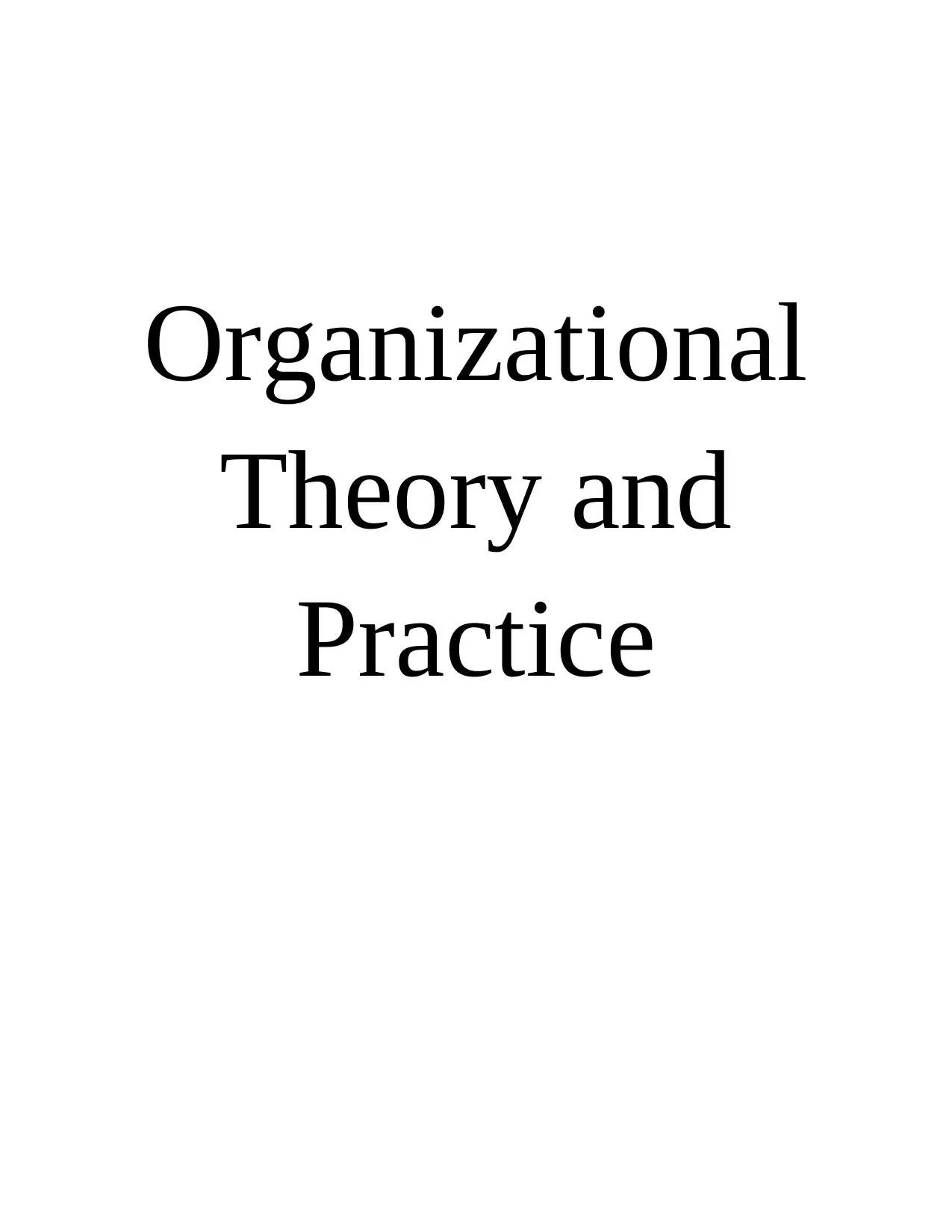
Organizational
Theory and
Practice
Theory and
Practice
Paraphrase This Document
Need a fresh take? Get an instant paraphrase of this document with our AI Paraphraser
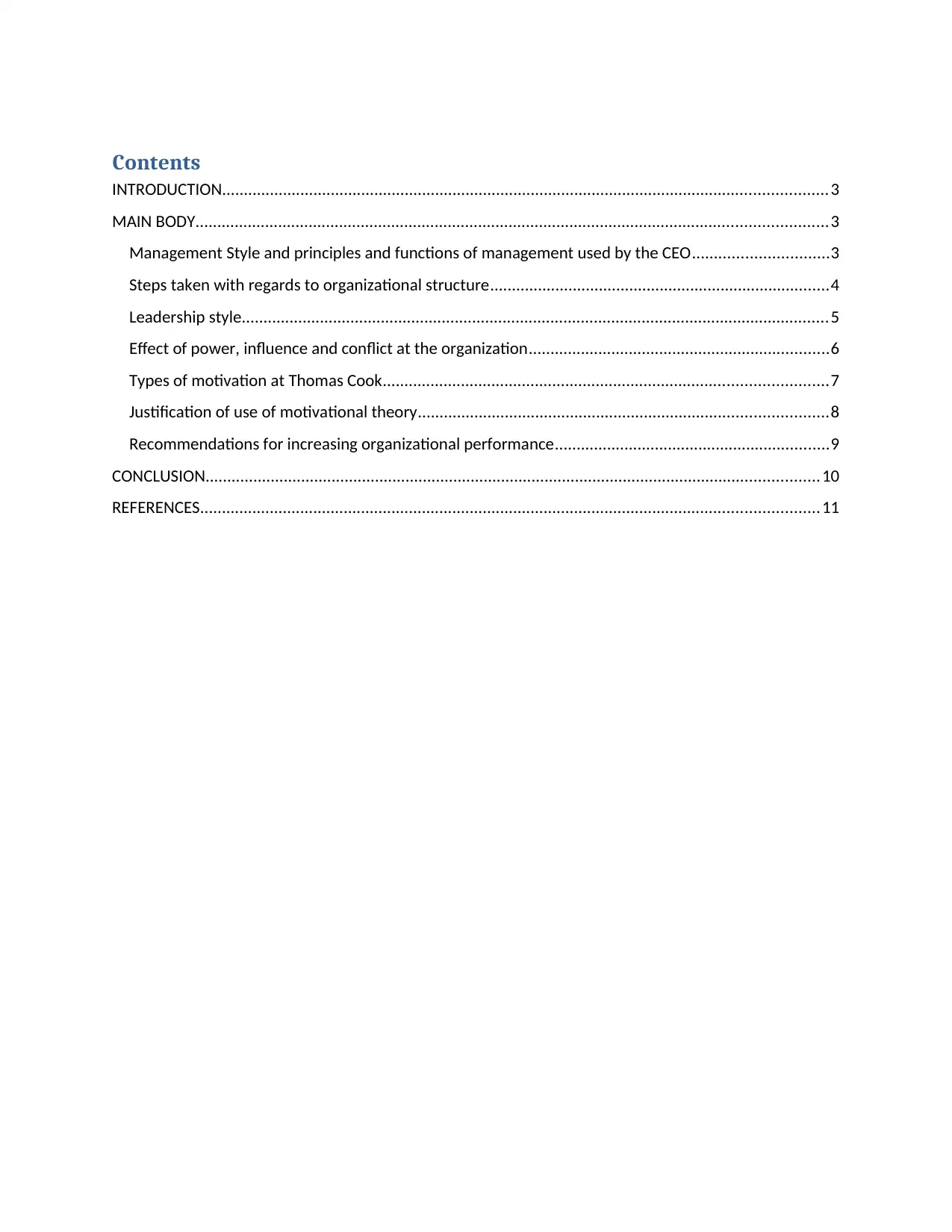
Contents
INTRODUCTION...........................................................................................................................................3
MAIN BODY.................................................................................................................................................3
Management Style and principles and functions of management used by the CEO...............................3
Steps taken with regards to organizational structure..............................................................................4
Leadership style.......................................................................................................................................5
Effect of power, influence and conflict at the organization.....................................................................6
Types of motivation at Thomas Cook......................................................................................................7
Justification of use of motivational theory..............................................................................................8
Recommendations for increasing organizational performance...............................................................9
CONCLUSION.............................................................................................................................................10
REFERENCES..............................................................................................................................................11
INTRODUCTION...........................................................................................................................................3
MAIN BODY.................................................................................................................................................3
Management Style and principles and functions of management used by the CEO...............................3
Steps taken with regards to organizational structure..............................................................................4
Leadership style.......................................................................................................................................5
Effect of power, influence and conflict at the organization.....................................................................6
Types of motivation at Thomas Cook......................................................................................................7
Justification of use of motivational theory..............................................................................................8
Recommendations for increasing organizational performance...............................................................9
CONCLUSION.............................................................................................................................................10
REFERENCES..............................................................................................................................................11
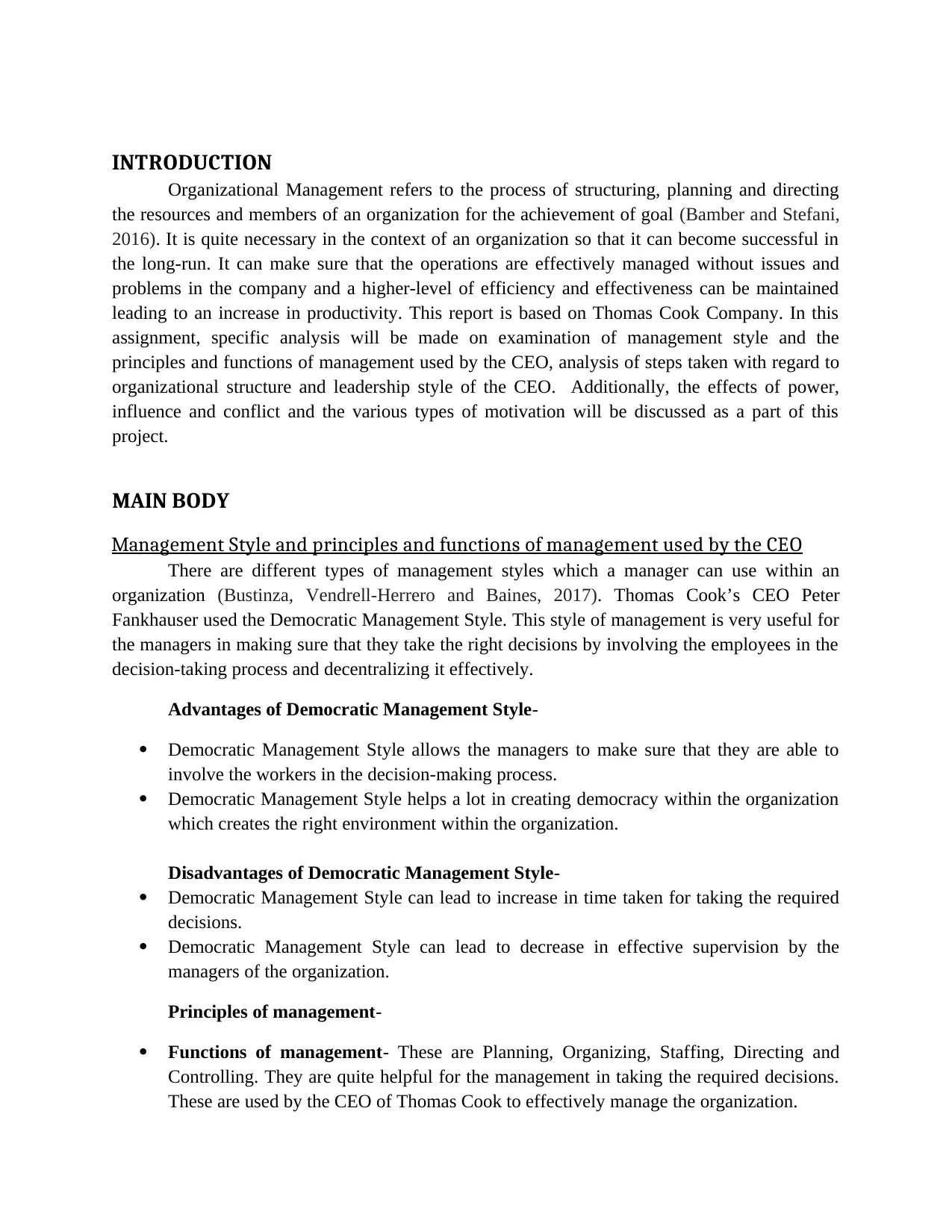
INTRODUCTION
Organizational Management refers to the process of structuring, planning and directing
the resources and members of an organization for the achievement of goal (Bamber and Stefani,
2016). It is quite necessary in the context of an organization so that it can become successful in
the long-run. It can make sure that the operations are effectively managed without issues and
problems in the company and a higher-level of efficiency and effectiveness can be maintained
leading to an increase in productivity. This report is based on Thomas Cook Company. In this
assignment, specific analysis will be made on examination of management style and the
principles and functions of management used by the CEO, analysis of steps taken with regard to
organizational structure and leadership style of the CEO. Additionally, the effects of power,
influence and conflict and the various types of motivation will be discussed as a part of this
project.
MAIN BODY
Management Style and principles and functions of management used by the CEO
There are different types of management styles which a manager can use within an
organization (Bustinza, Vendrell-Herrero and Baines, 2017). Thomas Cook’s CEO Peter
Fankhauser used the Democratic Management Style. This style of management is very useful for
the managers in making sure that they take the right decisions by involving the employees in the
decision-taking process and decentralizing it effectively.
Advantages of Democratic Management Style-
Democratic Management Style allows the managers to make sure that they are able to
involve the workers in the decision-making process.
Democratic Management Style helps a lot in creating democracy within the organization
which creates the right environment within the organization.
Disadvantages of Democratic Management Style-
Democratic Management Style can lead to increase in time taken for taking the required
decisions.
Democratic Management Style can lead to decrease in effective supervision by the
managers of the organization.
Principles of management-
Functions of management- These are Planning, Organizing, Staffing, Directing and
Controlling. They are quite helpful for the management in taking the required decisions.
These are used by the CEO of Thomas Cook to effectively manage the organization.
Organizational Management refers to the process of structuring, planning and directing
the resources and members of an organization for the achievement of goal (Bamber and Stefani,
2016). It is quite necessary in the context of an organization so that it can become successful in
the long-run. It can make sure that the operations are effectively managed without issues and
problems in the company and a higher-level of efficiency and effectiveness can be maintained
leading to an increase in productivity. This report is based on Thomas Cook Company. In this
assignment, specific analysis will be made on examination of management style and the
principles and functions of management used by the CEO, analysis of steps taken with regard to
organizational structure and leadership style of the CEO. Additionally, the effects of power,
influence and conflict and the various types of motivation will be discussed as a part of this
project.
MAIN BODY
Management Style and principles and functions of management used by the CEO
There are different types of management styles which a manager can use within an
organization (Bustinza, Vendrell-Herrero and Baines, 2017). Thomas Cook’s CEO Peter
Fankhauser used the Democratic Management Style. This style of management is very useful for
the managers in making sure that they take the right decisions by involving the employees in the
decision-taking process and decentralizing it effectively.
Advantages of Democratic Management Style-
Democratic Management Style allows the managers to make sure that they are able to
involve the workers in the decision-making process.
Democratic Management Style helps a lot in creating democracy within the organization
which creates the right environment within the organization.
Disadvantages of Democratic Management Style-
Democratic Management Style can lead to increase in time taken for taking the required
decisions.
Democratic Management Style can lead to decrease in effective supervision by the
managers of the organization.
Principles of management-
Functions of management- These are Planning, Organizing, Staffing, Directing and
Controlling. They are quite helpful for the management in taking the required decisions.
These are used by the CEO of Thomas Cook to effectively manage the organization.
⊘ This is a preview!⊘
Do you want full access?
Subscribe today to unlock all pages.

Trusted by 1+ million students worldwide
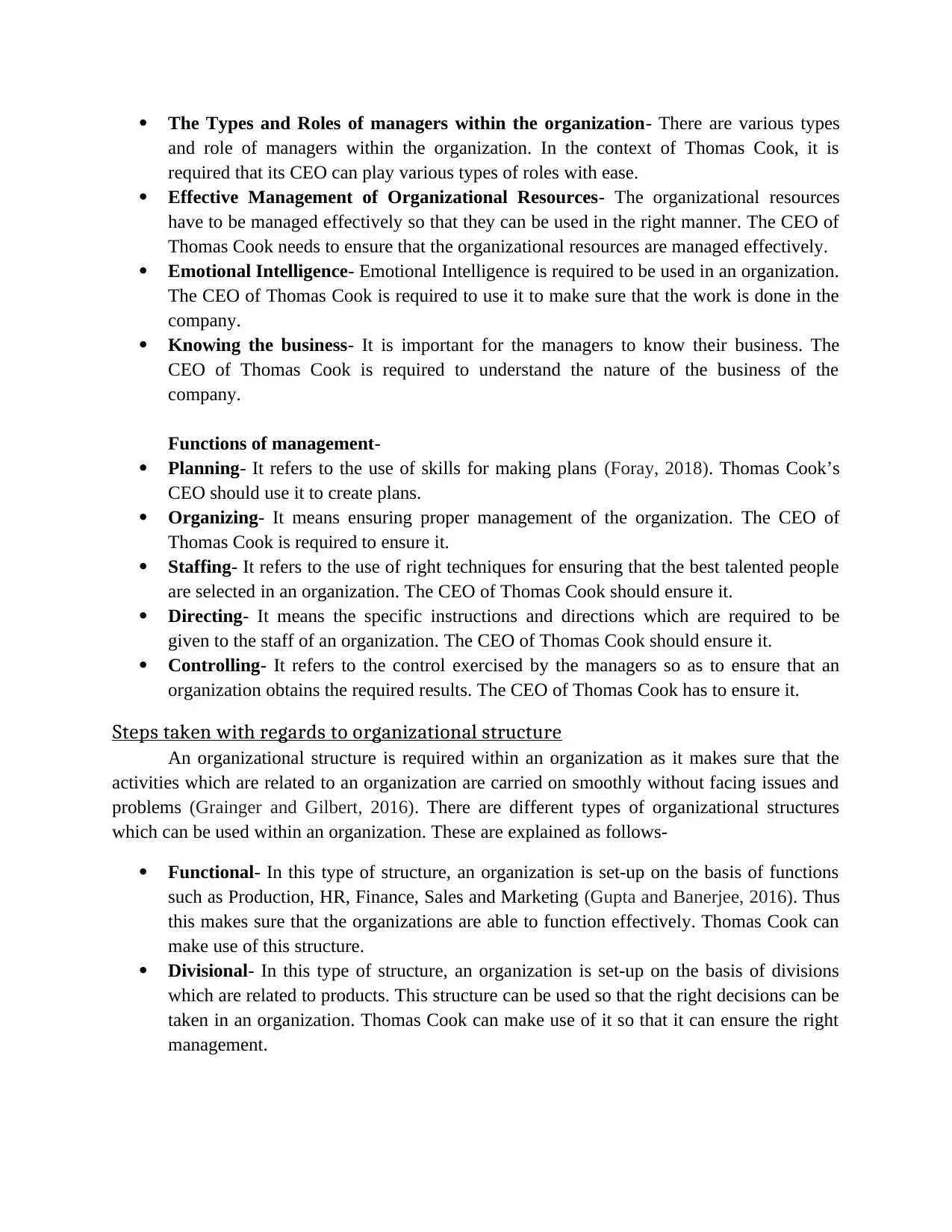
The Types and Roles of managers within the organization- There are various types
and role of managers within the organization. In the context of Thomas Cook, it is
required that its CEO can play various types of roles with ease.
Effective Management of Organizational Resources- The organizational resources
have to be managed effectively so that they can be used in the right manner. The CEO of
Thomas Cook needs to ensure that the organizational resources are managed effectively.
Emotional Intelligence- Emotional Intelligence is required to be used in an organization.
The CEO of Thomas Cook is required to use it to make sure that the work is done in the
company.
Knowing the business- It is important for the managers to know their business. The
CEO of Thomas Cook is required to understand the nature of the business of the
company.
Functions of management-
Planning- It refers to the use of skills for making plans (Foray, 2018). Thomas Cook’s
CEO should use it to create plans.
Organizing- It means ensuring proper management of the organization. The CEO of
Thomas Cook is required to ensure it.
Staffing- It refers to the use of right techniques for ensuring that the best talented people
are selected in an organization. The CEO of Thomas Cook should ensure it.
Directing- It means the specific instructions and directions which are required to be
given to the staff of an organization. The CEO of Thomas Cook should ensure it.
Controlling- It refers to the control exercised by the managers so as to ensure that an
organization obtains the required results. The CEO of Thomas Cook has to ensure it.
Steps taken with regards to organizational structure
An organizational structure is required within an organization as it makes sure that the
activities which are related to an organization are carried on smoothly without facing issues and
problems (Grainger and Gilbert, 2016). There are different types of organizational structures
which can be used within an organization. These are explained as follows-
Functional- In this type of structure, an organization is set-up on the basis of functions
such as Production, HR, Finance, Sales and Marketing (Gupta and Banerjee, 2016). Thus
this makes sure that the organizations are able to function effectively. Thomas Cook can
make use of this structure.
Divisional- In this type of structure, an organization is set-up on the basis of divisions
which are related to products. This structure can be used so that the right decisions can be
taken in an organization. Thomas Cook can make use of it so that it can ensure the right
management.
and role of managers within the organization. In the context of Thomas Cook, it is
required that its CEO can play various types of roles with ease.
Effective Management of Organizational Resources- The organizational resources
have to be managed effectively so that they can be used in the right manner. The CEO of
Thomas Cook needs to ensure that the organizational resources are managed effectively.
Emotional Intelligence- Emotional Intelligence is required to be used in an organization.
The CEO of Thomas Cook is required to use it to make sure that the work is done in the
company.
Knowing the business- It is important for the managers to know their business. The
CEO of Thomas Cook is required to understand the nature of the business of the
company.
Functions of management-
Planning- It refers to the use of skills for making plans (Foray, 2018). Thomas Cook’s
CEO should use it to create plans.
Organizing- It means ensuring proper management of the organization. The CEO of
Thomas Cook is required to ensure it.
Staffing- It refers to the use of right techniques for ensuring that the best talented people
are selected in an organization. The CEO of Thomas Cook should ensure it.
Directing- It means the specific instructions and directions which are required to be
given to the staff of an organization. The CEO of Thomas Cook should ensure it.
Controlling- It refers to the control exercised by the managers so as to ensure that an
organization obtains the required results. The CEO of Thomas Cook has to ensure it.
Steps taken with regards to organizational structure
An organizational structure is required within an organization as it makes sure that the
activities which are related to an organization are carried on smoothly without facing issues and
problems (Grainger and Gilbert, 2016). There are different types of organizational structures
which can be used within an organization. These are explained as follows-
Functional- In this type of structure, an organization is set-up on the basis of functions
such as Production, HR, Finance, Sales and Marketing (Gupta and Banerjee, 2016). Thus
this makes sure that the organizations are able to function effectively. Thomas Cook can
make use of this structure.
Divisional- In this type of structure, an organization is set-up on the basis of divisions
which are related to products. This structure can be used so that the right decisions can be
taken in an organization. Thomas Cook can make use of it so that it can ensure the right
management.
Paraphrase This Document
Need a fresh take? Get an instant paraphrase of this document with our AI Paraphraser
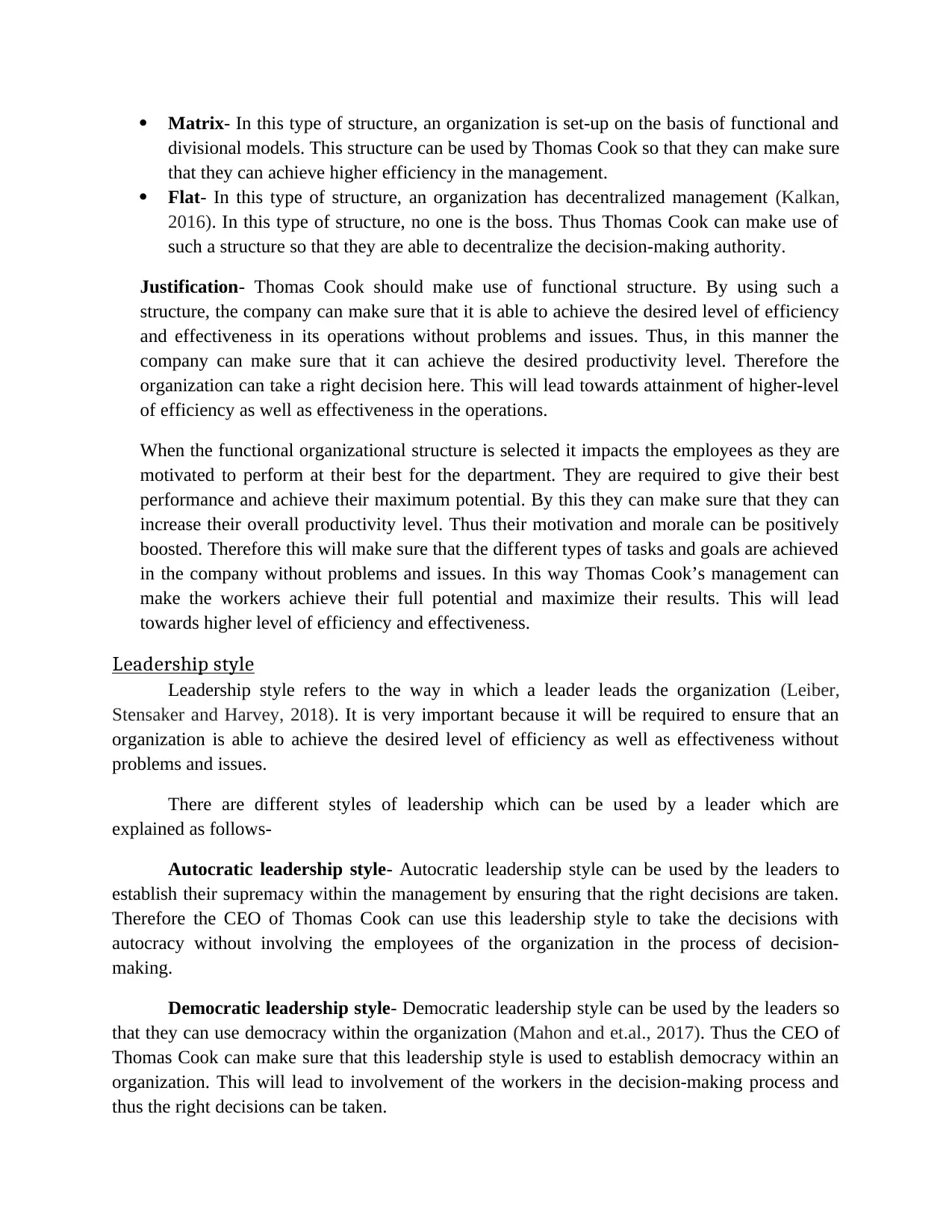
Matrix- In this type of structure, an organization is set-up on the basis of functional and
divisional models. This structure can be used by Thomas Cook so that they can make sure
that they can achieve higher efficiency in the management.
Flat- In this type of structure, an organization has decentralized management (Kalkan,
2016). In this type of structure, no one is the boss. Thus Thomas Cook can make use of
such a structure so that they are able to decentralize the decision-making authority.
Justification- Thomas Cook should make use of functional structure. By using such a
structure, the company can make sure that it is able to achieve the desired level of efficiency
and effectiveness in its operations without problems and issues. Thus, in this manner the
company can make sure that it can achieve the desired productivity level. Therefore the
organization can take a right decision here. This will lead towards attainment of higher-level
of efficiency as well as effectiveness in the operations.
When the functional organizational structure is selected it impacts the employees as they are
motivated to perform at their best for the department. They are required to give their best
performance and achieve their maximum potential. By this they can make sure that they can
increase their overall productivity level. Thus their motivation and morale can be positively
boosted. Therefore this will make sure that the different types of tasks and goals are achieved
in the company without problems and issues. In this way Thomas Cook’s management can
make the workers achieve their full potential and maximize their results. This will lead
towards higher level of efficiency and effectiveness.
Leadership style
Leadership style refers to the way in which a leader leads the organization (Leiber,
Stensaker and Harvey, 2018). It is very important because it will be required to ensure that an
organization is able to achieve the desired level of efficiency as well as effectiveness without
problems and issues.
There are different styles of leadership which can be used by a leader which are
explained as follows-
Autocratic leadership style- Autocratic leadership style can be used by the leaders to
establish their supremacy within the management by ensuring that the right decisions are taken.
Therefore the CEO of Thomas Cook can use this leadership style to take the decisions with
autocracy without involving the employees of the organization in the process of decision-
making.
Democratic leadership style- Democratic leadership style can be used by the leaders so
that they can use democracy within the organization (Mahon and et.al., 2017). Thus the CEO of
Thomas Cook can make sure that this leadership style is used to establish democracy within an
organization. This will lead to involvement of the workers in the decision-making process and
thus the right decisions can be taken.
divisional models. This structure can be used by Thomas Cook so that they can make sure
that they can achieve higher efficiency in the management.
Flat- In this type of structure, an organization has decentralized management (Kalkan,
2016). In this type of structure, no one is the boss. Thus Thomas Cook can make use of
such a structure so that they are able to decentralize the decision-making authority.
Justification- Thomas Cook should make use of functional structure. By using such a
structure, the company can make sure that it is able to achieve the desired level of efficiency
and effectiveness in its operations without problems and issues. Thus, in this manner the
company can make sure that it can achieve the desired productivity level. Therefore the
organization can take a right decision here. This will lead towards attainment of higher-level
of efficiency as well as effectiveness in the operations.
When the functional organizational structure is selected it impacts the employees as they are
motivated to perform at their best for the department. They are required to give their best
performance and achieve their maximum potential. By this they can make sure that they can
increase their overall productivity level. Thus their motivation and morale can be positively
boosted. Therefore this will make sure that the different types of tasks and goals are achieved
in the company without problems and issues. In this way Thomas Cook’s management can
make the workers achieve their full potential and maximize their results. This will lead
towards higher level of efficiency and effectiveness.
Leadership style
Leadership style refers to the way in which a leader leads the organization (Leiber,
Stensaker and Harvey, 2018). It is very important because it will be required to ensure that an
organization is able to achieve the desired level of efficiency as well as effectiveness without
problems and issues.
There are different styles of leadership which can be used by a leader which are
explained as follows-
Autocratic leadership style- Autocratic leadership style can be used by the leaders to
establish their supremacy within the management by ensuring that the right decisions are taken.
Therefore the CEO of Thomas Cook can use this leadership style to take the decisions with
autocracy without involving the employees of the organization in the process of decision-
making.
Democratic leadership style- Democratic leadership style can be used by the leaders so
that they can use democracy within the organization (Mahon and et.al., 2017). Thus the CEO of
Thomas Cook can make sure that this leadership style is used to establish democracy within an
organization. This will lead to involvement of the workers in the decision-making process and
thus the right decisions can be taken.

Laissez-Faire leadership style- Laissez-Faire leadership style can be used by the leaders
to allow the complete authority to run the operations to the subordinates. Here, the leader only
interferes in important matters and the rest of the decisions are taken by the subordinates without
problems and issues. In Thomas Cook, this leadership style can be adopted by the CEO which h
will make sure that the company’s subordinates are able to take the right decisions by themselves
without necessarily consulting the leaders of the organization.
Justification- CEO of Thomas Cook should use Democratic leadership style because
using it will ensure that the democracy is maintained within the organization. The adopting of
such a style is necessary for the organization because it decentralizes the decision-taking
authority and allows the subordinates to learn the art of taking the right decisions so that they are
able to develop their leadership and management skills for the future time period which his going
to help the company in the long-run period.
Effect of power, influence and conflict at the organization
Organizational power- Organizational power refers to the ability of making the desired
things happen in the organization according to one’s own will (Maylor and Turner, 2017). The
managers of an organization have this so that they can take the desired actions in the
organization for achieving the short-term and long-term goals as well as objectives.
In Thomas Cook, the organizational power is used in the right manner. The CEO takes
the major decisions and delegates the power to take other important decisions to the staff of the
organization. This ensures that the right decisions are taken in the company and consultancy is
done with the leaders on several important matters.
Organizational influence- Organizational influence refers to the influence which certain
people enjoy in the organization due to their position or knowledge (Nicolini and Monteiro,
2017). It is required in a company so that the work can be done without problems and issues and
the staff members can be influenced to give their best at their maximum potential for the cause of
the organization.
In the context of Thomas Cook, the organizational influence can be used in the right
manner. The CEO of Thomas Cook needs to ensure that there is a certain influence which the
management enjoys in the organization to take the major decisions. This establishes better
control in the organization and helps a lot in taking the desired actions for maintaining the
overall level of efficiency as well as effectiveness.
Organizational conflict- Organizational conflict refers to the conflicts which happen
between different members in the organization (Patterson, Zibarras and Ashworth, 2016). They
have an impact on the working of an organization and can affect it.
In the context of Thomas Cook, these conflicts can happen due to the diverse teams
which are present in it. There are different types of teams in the company such as Finance, HR,
to allow the complete authority to run the operations to the subordinates. Here, the leader only
interferes in important matters and the rest of the decisions are taken by the subordinates without
problems and issues. In Thomas Cook, this leadership style can be adopted by the CEO which h
will make sure that the company’s subordinates are able to take the right decisions by themselves
without necessarily consulting the leaders of the organization.
Justification- CEO of Thomas Cook should use Democratic leadership style because
using it will ensure that the democracy is maintained within the organization. The adopting of
such a style is necessary for the organization because it decentralizes the decision-taking
authority and allows the subordinates to learn the art of taking the right decisions so that they are
able to develop their leadership and management skills for the future time period which his going
to help the company in the long-run period.
Effect of power, influence and conflict at the organization
Organizational power- Organizational power refers to the ability of making the desired
things happen in the organization according to one’s own will (Maylor and Turner, 2017). The
managers of an organization have this so that they can take the desired actions in the
organization for achieving the short-term and long-term goals as well as objectives.
In Thomas Cook, the organizational power is used in the right manner. The CEO takes
the major decisions and delegates the power to take other important decisions to the staff of the
organization. This ensures that the right decisions are taken in the company and consultancy is
done with the leaders on several important matters.
Organizational influence- Organizational influence refers to the influence which certain
people enjoy in the organization due to their position or knowledge (Nicolini and Monteiro,
2017). It is required in a company so that the work can be done without problems and issues and
the staff members can be influenced to give their best at their maximum potential for the cause of
the organization.
In the context of Thomas Cook, the organizational influence can be used in the right
manner. The CEO of Thomas Cook needs to ensure that there is a certain influence which the
management enjoys in the organization to take the major decisions. This establishes better
control in the organization and helps a lot in taking the desired actions for maintaining the
overall level of efficiency as well as effectiveness.
Organizational conflict- Organizational conflict refers to the conflicts which happen
between different members in the organization (Patterson, Zibarras and Ashworth, 2016). They
have an impact on the working of an organization and can affect it.
In the context of Thomas Cook, these conflicts can happen due to the diverse teams
which are present in it. There are different types of teams in the company such as Finance, HR,
⊘ This is a preview!⊘
Do you want full access?
Subscribe today to unlock all pages.

Trusted by 1+ million students worldwide
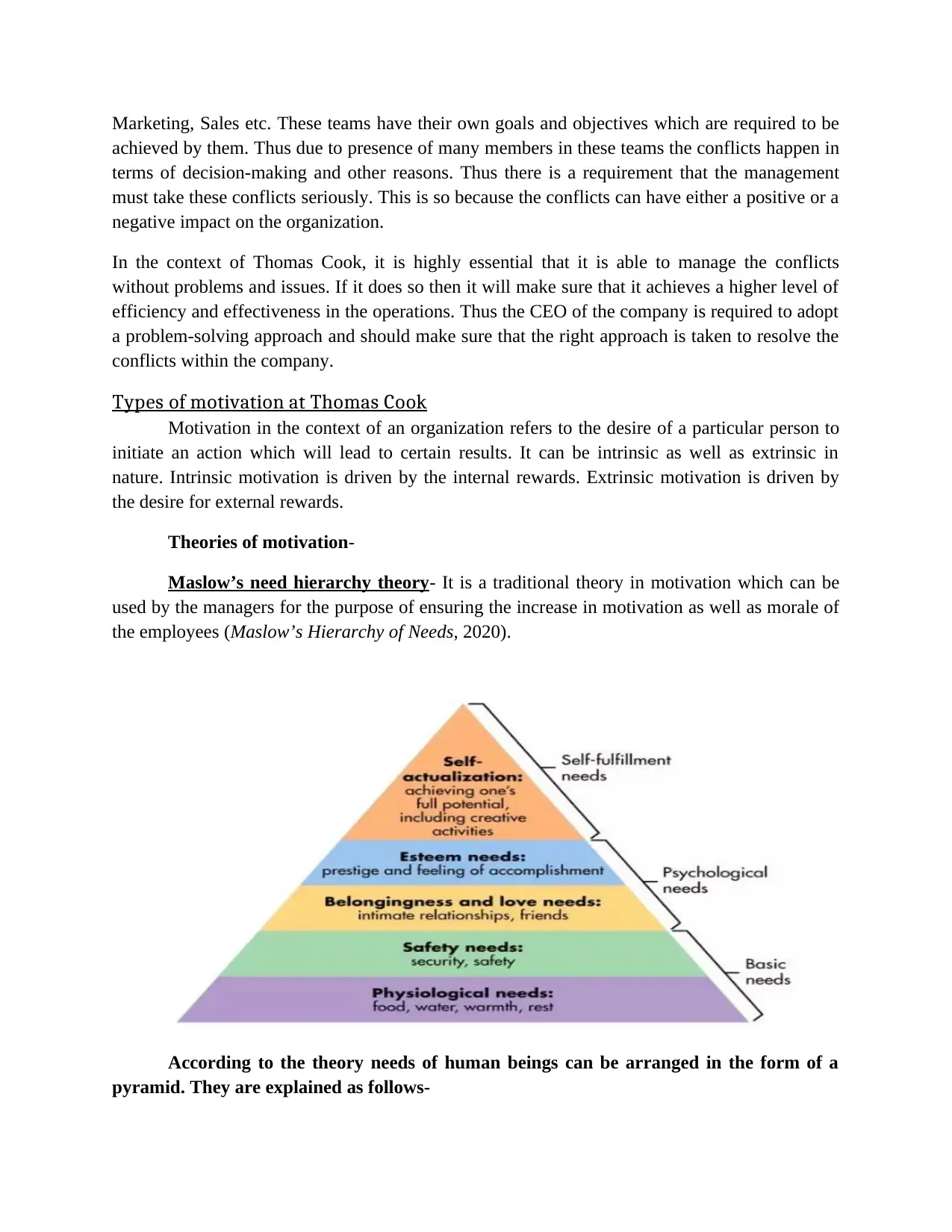
Marketing, Sales etc. These teams have their own goals and objectives which are required to be
achieved by them. Thus due to presence of many members in these teams the conflicts happen in
terms of decision-making and other reasons. Thus there is a requirement that the management
must take these conflicts seriously. This is so because the conflicts can have either a positive or a
negative impact on the organization.
In the context of Thomas Cook, it is highly essential that it is able to manage the conflicts
without problems and issues. If it does so then it will make sure that it achieves a higher level of
efficiency and effectiveness in the operations. Thus the CEO of the company is required to adopt
a problem-solving approach and should make sure that the right approach is taken to resolve the
conflicts within the company.
Types of motivation at Thomas Cook
Motivation in the context of an organization refers to the desire of a particular person to
initiate an action which will lead to certain results. It can be intrinsic as well as extrinsic in
nature. Intrinsic motivation is driven by the internal rewards. Extrinsic motivation is driven by
the desire for external rewards.
Theories of motivation-
Maslow’s need hierarchy theory- It is a traditional theory in motivation which can be
used by the managers for the purpose of ensuring the increase in motivation as well as morale of
the employees (Maslow’s Hierarchy of Needs, 2020).
According to the theory needs of human beings can be arranged in the form of a
pyramid. They are explained as follows-
achieved by them. Thus due to presence of many members in these teams the conflicts happen in
terms of decision-making and other reasons. Thus there is a requirement that the management
must take these conflicts seriously. This is so because the conflicts can have either a positive or a
negative impact on the organization.
In the context of Thomas Cook, it is highly essential that it is able to manage the conflicts
without problems and issues. If it does so then it will make sure that it achieves a higher level of
efficiency and effectiveness in the operations. Thus the CEO of the company is required to adopt
a problem-solving approach and should make sure that the right approach is taken to resolve the
conflicts within the company.
Types of motivation at Thomas Cook
Motivation in the context of an organization refers to the desire of a particular person to
initiate an action which will lead to certain results. It can be intrinsic as well as extrinsic in
nature. Intrinsic motivation is driven by the internal rewards. Extrinsic motivation is driven by
the desire for external rewards.
Theories of motivation-
Maslow’s need hierarchy theory- It is a traditional theory in motivation which can be
used by the managers for the purpose of ensuring the increase in motivation as well as morale of
the employees (Maslow’s Hierarchy of Needs, 2020).
According to the theory needs of human beings can be arranged in the form of a
pyramid. They are explained as follows-
Paraphrase This Document
Need a fresh take? Get an instant paraphrase of this document with our AI Paraphraser

Physiological needs- These are basic needs of the human beings which are required to be
fulfilled. These are extremely essential and are required to be fulfilled by Thomas Cook.
Safety needs- These are needs related to individual’s safety and must be fulfilled. They
are essential and should be fulfilled by Thomas Cook.
Love and Belongingness needs- These needs are related with love and belongingness
which is desired by all individuals. They have to be fulfilled by Thomas Cook.
Esteem needs- These needs are related with self-respect and esteem of an individual.
They are required to be fulfilled by Thomas Cook.
Self-actualization needs- These needs are related with self-actualization and the higher
potential which an employee can achieve. These can be fulfilled by Thomas Cook.
Vroom’s expectancy theory- Vroom’s expectancy theory states that behavior is a result
of conscious choices among the alternatives (Reedy, 2020). The purpose is to minimize pain and
maximize the level of pleasure.
The elements in this theory are as follows-
Expectancy- Expectancy is the belief that with an increase in efforts the performance can
be enhanced. Thus Thomas Cook’s managers are required to motivate their staff to improve their
efforts to derive higher-level performance.
Instrumentality- Instrumentality refers to a belief by performing well a desirable
outcome can be achieved (Shuck, Adelson and Reio Jr, 2017). Therefore in the context of
Thomas Cook it is required that its managers motivate the employees to perform well to achieve
the outcomes.
Valence- Valence refers to the importance which is placed by an individual to achieve
the expected outcome (Stahl and et.al., 2017). For Thomas Cook, it is essential that managers are
able to motivate the employees to place the required importance so that they can achieve the
desired outcomes without problems and issues which will lead to increase in efficiency and
effectiveness.
Justification of use of motivational theory
The motivation of an employee can be increased in the organization if the right
motivational theory is used by the managers of an organization (Swyngedouw, 2017). The
managers of Thomas Cook should make use of the Maslow’s Need Hierarchy Theory. The
justification for the use of this theory is as follows-
Identification of needs- This theory helps in identifying needs. Using this theory can
allow the managers of Thomas Cook to identify the various types of needs which the
fulfilled. These are extremely essential and are required to be fulfilled by Thomas Cook.
Safety needs- These are needs related to individual’s safety and must be fulfilled. They
are essential and should be fulfilled by Thomas Cook.
Love and Belongingness needs- These needs are related with love and belongingness
which is desired by all individuals. They have to be fulfilled by Thomas Cook.
Esteem needs- These needs are related with self-respect and esteem of an individual.
They are required to be fulfilled by Thomas Cook.
Self-actualization needs- These needs are related with self-actualization and the higher
potential which an employee can achieve. These can be fulfilled by Thomas Cook.
Vroom’s expectancy theory- Vroom’s expectancy theory states that behavior is a result
of conscious choices among the alternatives (Reedy, 2020). The purpose is to minimize pain and
maximize the level of pleasure.
The elements in this theory are as follows-
Expectancy- Expectancy is the belief that with an increase in efforts the performance can
be enhanced. Thus Thomas Cook’s managers are required to motivate their staff to improve their
efforts to derive higher-level performance.
Instrumentality- Instrumentality refers to a belief by performing well a desirable
outcome can be achieved (Shuck, Adelson and Reio Jr, 2017). Therefore in the context of
Thomas Cook it is required that its managers motivate the employees to perform well to achieve
the outcomes.
Valence- Valence refers to the importance which is placed by an individual to achieve
the expected outcome (Stahl and et.al., 2017). For Thomas Cook, it is essential that managers are
able to motivate the employees to place the required importance so that they can achieve the
desired outcomes without problems and issues which will lead to increase in efficiency and
effectiveness.
Justification of use of motivational theory
The motivation of an employee can be increased in the organization if the right
motivational theory is used by the managers of an organization (Swyngedouw, 2017). The
managers of Thomas Cook should make use of the Maslow’s Need Hierarchy Theory. The
justification for the use of this theory is as follows-
Identification of needs- This theory helps in identifying needs. Using this theory can
allow the managers of Thomas Cook to identify the various types of needs which the
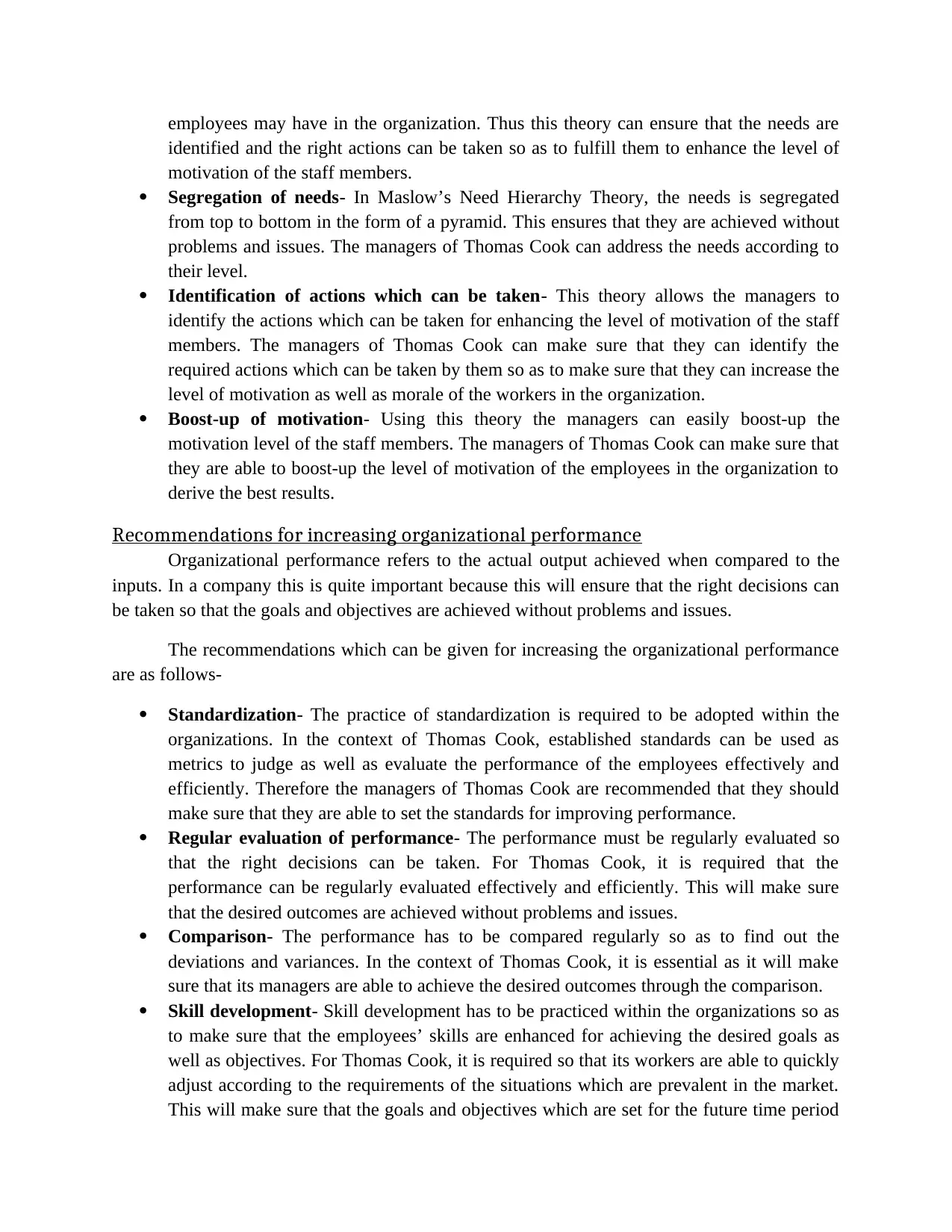
employees may have in the organization. Thus this theory can ensure that the needs are
identified and the right actions can be taken so as to fulfill them to enhance the level of
motivation of the staff members.
Segregation of needs- In Maslow’s Need Hierarchy Theory, the needs is segregated
from top to bottom in the form of a pyramid. This ensures that they are achieved without
problems and issues. The managers of Thomas Cook can address the needs according to
their level.
Identification of actions which can be taken- This theory allows the managers to
identify the actions which can be taken for enhancing the level of motivation of the staff
members. The managers of Thomas Cook can make sure that they can identify the
required actions which can be taken by them so as to make sure that they can increase the
level of motivation as well as morale of the workers in the organization.
Boost-up of motivation- Using this theory the managers can easily boost-up the
motivation level of the staff members. The managers of Thomas Cook can make sure that
they are able to boost-up the level of motivation of the employees in the organization to
derive the best results.
Recommendations for increasing organizational performance
Organizational performance refers to the actual output achieved when compared to the
inputs. In a company this is quite important because this will ensure that the right decisions can
be taken so that the goals and objectives are achieved without problems and issues.
The recommendations which can be given for increasing the organizational performance
are as follows-
Standardization- The practice of standardization is required to be adopted within the
organizations. In the context of Thomas Cook, established standards can be used as
metrics to judge as well as evaluate the performance of the employees effectively and
efficiently. Therefore the managers of Thomas Cook are recommended that they should
make sure that they are able to set the standards for improving performance.
Regular evaluation of performance- The performance must be regularly evaluated so
that the right decisions can be taken. For Thomas Cook, it is required that the
performance can be regularly evaluated effectively and efficiently. This will make sure
that the desired outcomes are achieved without problems and issues.
Comparison- The performance has to be compared regularly so as to find out the
deviations and variances. In the context of Thomas Cook, it is essential as it will make
sure that its managers are able to achieve the desired outcomes through the comparison.
Skill development- Skill development has to be practiced within the organizations so as
to make sure that the employees’ skills are enhanced for achieving the desired goals as
well as objectives. For Thomas Cook, it is required so that its workers are able to quickly
adjust according to the requirements of the situations which are prevalent in the market.
This will make sure that the goals and objectives which are set for the future time period
identified and the right actions can be taken so as to fulfill them to enhance the level of
motivation of the staff members.
Segregation of needs- In Maslow’s Need Hierarchy Theory, the needs is segregated
from top to bottom in the form of a pyramid. This ensures that they are achieved without
problems and issues. The managers of Thomas Cook can address the needs according to
their level.
Identification of actions which can be taken- This theory allows the managers to
identify the actions which can be taken for enhancing the level of motivation of the staff
members. The managers of Thomas Cook can make sure that they can identify the
required actions which can be taken by them so as to make sure that they can increase the
level of motivation as well as morale of the workers in the organization.
Boost-up of motivation- Using this theory the managers can easily boost-up the
motivation level of the staff members. The managers of Thomas Cook can make sure that
they are able to boost-up the level of motivation of the employees in the organization to
derive the best results.
Recommendations for increasing organizational performance
Organizational performance refers to the actual output achieved when compared to the
inputs. In a company this is quite important because this will ensure that the right decisions can
be taken so that the goals and objectives are achieved without problems and issues.
The recommendations which can be given for increasing the organizational performance
are as follows-
Standardization- The practice of standardization is required to be adopted within the
organizations. In the context of Thomas Cook, established standards can be used as
metrics to judge as well as evaluate the performance of the employees effectively and
efficiently. Therefore the managers of Thomas Cook are recommended that they should
make sure that they are able to set the standards for improving performance.
Regular evaluation of performance- The performance must be regularly evaluated so
that the right decisions can be taken. For Thomas Cook, it is required that the
performance can be regularly evaluated effectively and efficiently. This will make sure
that the desired outcomes are achieved without problems and issues.
Comparison- The performance has to be compared regularly so as to find out the
deviations and variances. In the context of Thomas Cook, it is essential as it will make
sure that its managers are able to achieve the desired outcomes through the comparison.
Skill development- Skill development has to be practiced within the organizations so as
to make sure that the employees’ skills are enhanced for achieving the desired goals as
well as objectives. For Thomas Cook, it is required so that its workers are able to quickly
adjust according to the requirements of the situations which are prevalent in the market.
This will make sure that the goals and objectives which are set for the future time period
⊘ This is a preview!⊘
Do you want full access?
Subscribe today to unlock all pages.

Trusted by 1+ million students worldwide
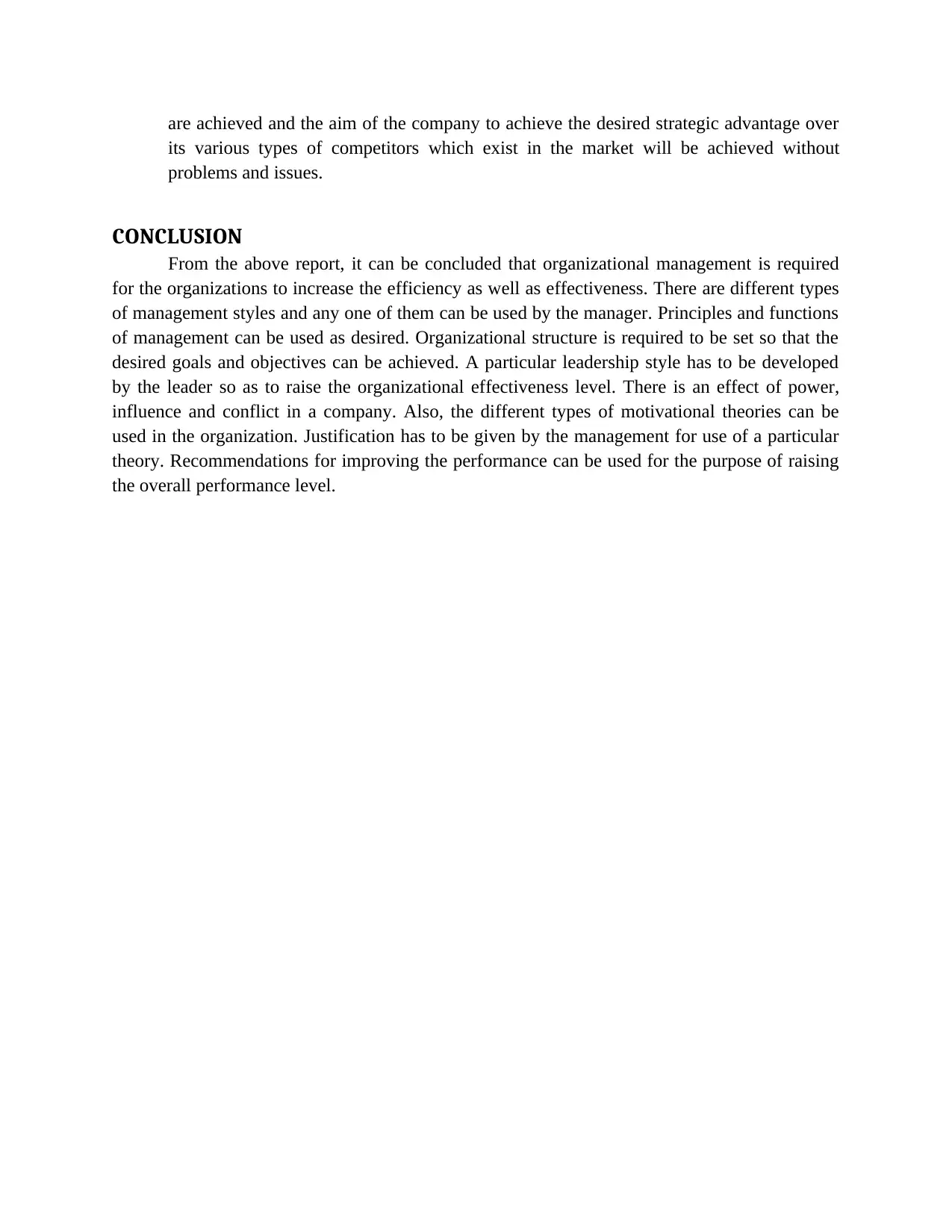
are achieved and the aim of the company to achieve the desired strategic advantage over
its various types of competitors which exist in the market will be achieved without
problems and issues.
CONCLUSION
From the above report, it can be concluded that organizational management is required
for the organizations to increase the efficiency as well as effectiveness. There are different types
of management styles and any one of them can be used by the manager. Principles and functions
of management can be used as desired. Organizational structure is required to be set so that the
desired goals and objectives can be achieved. A particular leadership style has to be developed
by the leader so as to raise the organizational effectiveness level. There is an effect of power,
influence and conflict in a company. Also, the different types of motivational theories can be
used in the organization. Justification has to be given by the management for use of a particular
theory. Recommendations for improving the performance can be used for the purpose of raising
the overall performance level.
its various types of competitors which exist in the market will be achieved without
problems and issues.
CONCLUSION
From the above report, it can be concluded that organizational management is required
for the organizations to increase the efficiency as well as effectiveness. There are different types
of management styles and any one of them can be used by the manager. Principles and functions
of management can be used as desired. Organizational structure is required to be set so that the
desired goals and objectives can be achieved. A particular leadership style has to be developed
by the leader so as to raise the organizational effectiveness level. There is an effect of power,
influence and conflict in a company. Also, the different types of motivational theories can be
used in the organization. Justification has to be given by the management for use of a particular
theory. Recommendations for improving the performance can be used for the purpose of raising
the overall performance level.
Paraphrase This Document
Need a fresh take? Get an instant paraphrase of this document with our AI Paraphraser
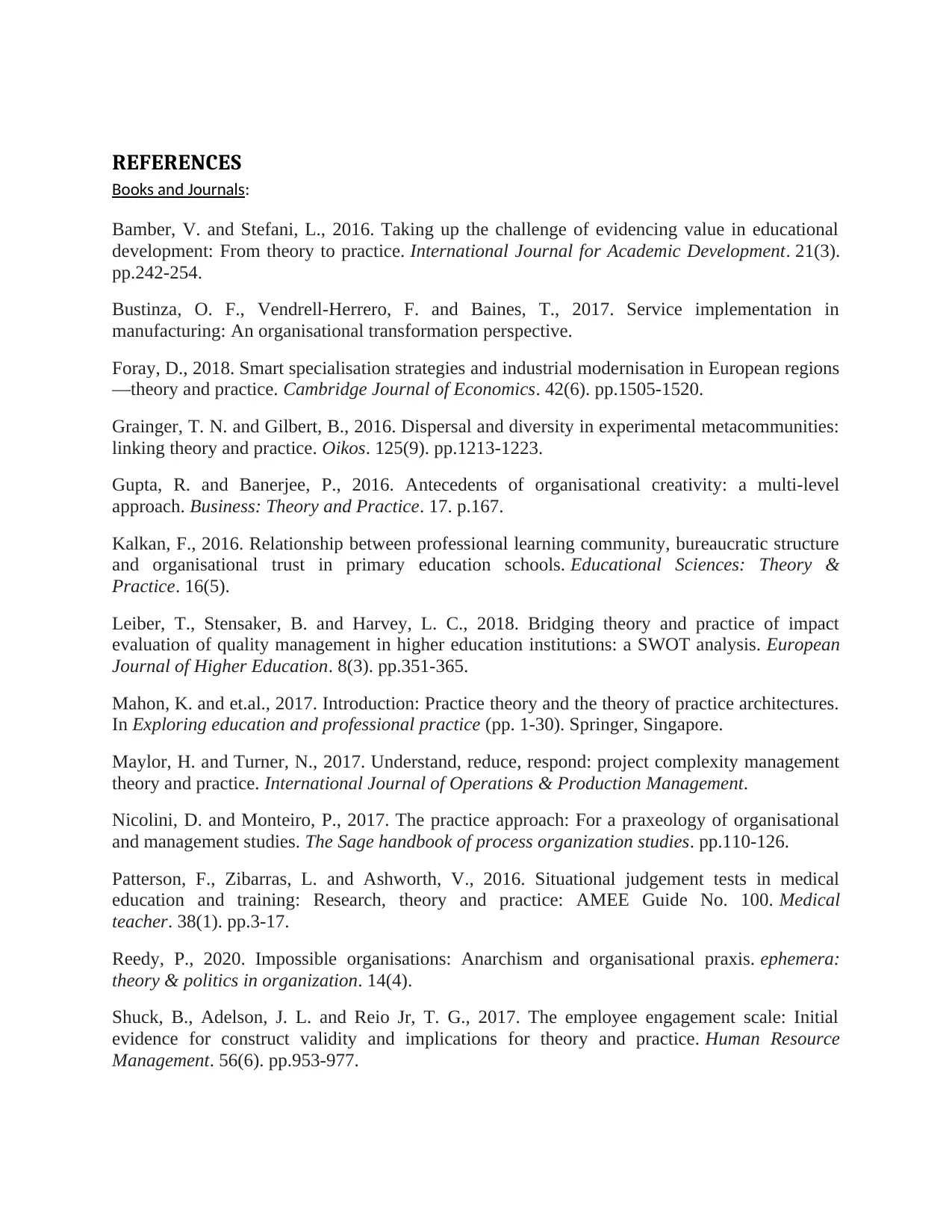
REFERENCES
Books and Journals:
Bamber, V. and Stefani, L., 2016. Taking up the challenge of evidencing value in educational
development: From theory to practice. International Journal for Academic Development. 21(3).
pp.242-254.
Bustinza, O. F., Vendrell-Herrero, F. and Baines, T., 2017. Service implementation in
manufacturing: An organisational transformation perspective.
Foray, D., 2018. Smart specialisation strategies and industrial modernisation in European regions
—theory and practice. Cambridge Journal of Economics. 42(6). pp.1505-1520.
Grainger, T. N. and Gilbert, B., 2016. Dispersal and diversity in experimental metacommunities:
linking theory and practice. Oikos. 125(9). pp.1213-1223.
Gupta, R. and Banerjee, P., 2016. Antecedents of organisational creativity: a multi-level
approach. Business: Theory and Practice. 17. p.167.
Kalkan, F., 2016. Relationship between professional learning community, bureaucratic structure
and organisational trust in primary education schools. Educational Sciences: Theory &
Practice. 16(5).
Leiber, T., Stensaker, B. and Harvey, L. C., 2018. Bridging theory and practice of impact
evaluation of quality management in higher education institutions: a SWOT analysis. European
Journal of Higher Education. 8(3). pp.351-365.
Mahon, K. and et.al., 2017. Introduction: Practice theory and the theory of practice architectures.
In Exploring education and professional practice (pp. 1-30). Springer, Singapore.
Maylor, H. and Turner, N., 2017. Understand, reduce, respond: project complexity management
theory and practice. International Journal of Operations & Production Management.
Nicolini, D. and Monteiro, P., 2017. The practice approach: For a praxeology of organisational
and management studies. The Sage handbook of process organization studies. pp.110-126.
Patterson, F., Zibarras, L. and Ashworth, V., 2016. Situational judgement tests in medical
education and training: Research, theory and practice: AMEE Guide No. 100. Medical
teacher. 38(1). pp.3-17.
Reedy, P., 2020. Impossible organisations: Anarchism and organisational praxis. ephemera:
theory & politics in organization. 14(4).
Shuck, B., Adelson, J. L. and Reio Jr, T. G., 2017. The employee engagement scale: Initial
evidence for construct validity and implications for theory and practice. Human Resource
Management. 56(6). pp.953-977.
Books and Journals:
Bamber, V. and Stefani, L., 2016. Taking up the challenge of evidencing value in educational
development: From theory to practice. International Journal for Academic Development. 21(3).
pp.242-254.
Bustinza, O. F., Vendrell-Herrero, F. and Baines, T., 2017. Service implementation in
manufacturing: An organisational transformation perspective.
Foray, D., 2018. Smart specialisation strategies and industrial modernisation in European regions
—theory and practice. Cambridge Journal of Economics. 42(6). pp.1505-1520.
Grainger, T. N. and Gilbert, B., 2016. Dispersal and diversity in experimental metacommunities:
linking theory and practice. Oikos. 125(9). pp.1213-1223.
Gupta, R. and Banerjee, P., 2016. Antecedents of organisational creativity: a multi-level
approach. Business: Theory and Practice. 17. p.167.
Kalkan, F., 2016. Relationship between professional learning community, bureaucratic structure
and organisational trust in primary education schools. Educational Sciences: Theory &
Practice. 16(5).
Leiber, T., Stensaker, B. and Harvey, L. C., 2018. Bridging theory and practice of impact
evaluation of quality management in higher education institutions: a SWOT analysis. European
Journal of Higher Education. 8(3). pp.351-365.
Mahon, K. and et.al., 2017. Introduction: Practice theory and the theory of practice architectures.
In Exploring education and professional practice (pp. 1-30). Springer, Singapore.
Maylor, H. and Turner, N., 2017. Understand, reduce, respond: project complexity management
theory and practice. International Journal of Operations & Production Management.
Nicolini, D. and Monteiro, P., 2017. The practice approach: For a praxeology of organisational
and management studies. The Sage handbook of process organization studies. pp.110-126.
Patterson, F., Zibarras, L. and Ashworth, V., 2016. Situational judgement tests in medical
education and training: Research, theory and practice: AMEE Guide No. 100. Medical
teacher. 38(1). pp.3-17.
Reedy, P., 2020. Impossible organisations: Anarchism and organisational praxis. ephemera:
theory & politics in organization. 14(4).
Shuck, B., Adelson, J. L. and Reio Jr, T. G., 2017. The employee engagement scale: Initial
evidence for construct validity and implications for theory and practice. Human Resource
Management. 56(6). pp.953-977.

Stahl, B. C. and et.al., 2017. The responsible research and innovation (RRI) maturity model:
Linking theory and practice. Sustainability. 9(6). p.1036.
Swyngedouw, E., 2017. Unlocking the mind-trap: Politicising urban theory and practice. Urban
Studies. 54(1). pp.55-61.
Online
Maslow’s Hierarchy of Needs. 2020. [Online]. Available through:
<https://www.simplypsychology.org/maslow.html#:~:text=Maslow's%20hierarchy%20of
%20needs%20is,hierarchical%20levels%20within%20a%20pyramid.&text=From%20the
%20bottom%20of%20the,esteem%2C%20and%20self%2Dactualization.>
Linking theory and practice. Sustainability. 9(6). p.1036.
Swyngedouw, E., 2017. Unlocking the mind-trap: Politicising urban theory and practice. Urban
Studies. 54(1). pp.55-61.
Online
Maslow’s Hierarchy of Needs. 2020. [Online]. Available through:
<https://www.simplypsychology.org/maslow.html#:~:text=Maslow's%20hierarchy%20of
%20needs%20is,hierarchical%20levels%20within%20a%20pyramid.&text=From%20the
%20bottom%20of%20the,esteem%2C%20and%20self%2Dactualization.>
⊘ This is a preview!⊘
Do you want full access?
Subscribe today to unlock all pages.

Trusted by 1+ million students worldwide
1 out of 12
Related Documents
Your All-in-One AI-Powered Toolkit for Academic Success.
+13062052269
info@desklib.com
Available 24*7 on WhatsApp / Email
![[object Object]](/_next/static/media/star-bottom.7253800d.svg)
Unlock your academic potential
Copyright © 2020–2025 A2Z Services. All Rights Reserved. Developed and managed by ZUCOL.




